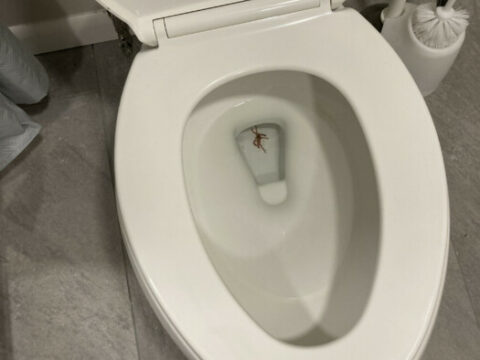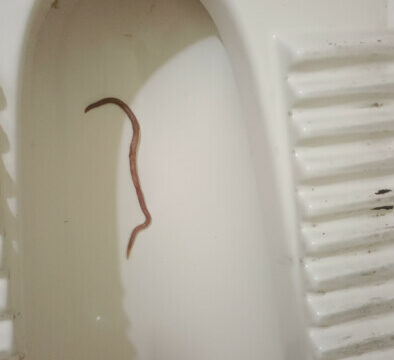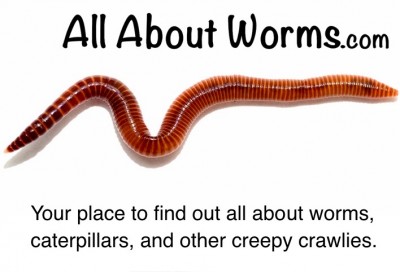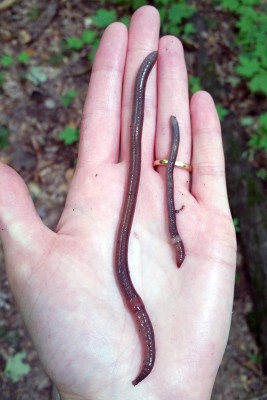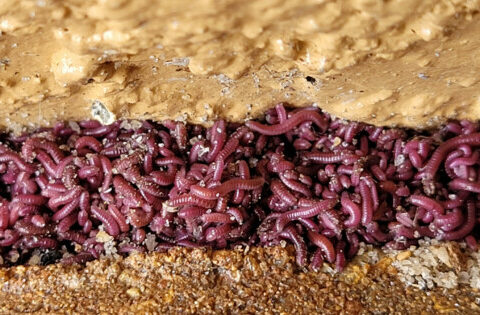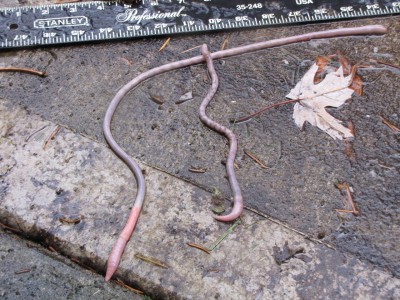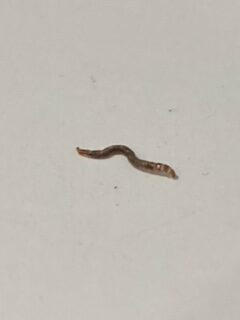Category: Segmented Worms Annelida
Do Worms Have Feet?
“Do worms have feet?” asks Max in his submission. He does not include any photos, or any more context behind his question, but we will do our best to answer it nonetheless. The short answer is ‘no’. But if we take this a step further and ask why worms do not have feet, we get to the root of what worms really are to begin with. It would probably take studying the evolutionary history of worms to fully understand where this creature came from and to explain its footless state. Funnily enough, “a fossilized worm found” only a few years ago had scientists speculating that this creature may have been “key to the evolution of much of the animal kingdom”. So maybe we were all footless, legless worms at some point in time.
Long Black Worm in Toilet is an Earthworm
“Tonight I went to use the bathroom to urinate but when I looked down I noticed a living worm there”, writes Alberto in his submission regarding the dark, long, worm-like creature pictured below. “My first thought was that the worm came from me, and that it was a parasite (I did use the bathroom in the morning, but I didn’t use the bathroom until the night when I saw the worm), but when I started researching in Google it didn’t seem like the worm looked like the typical parasite that infects humans. Those seem to be white or cream, while this worm looks black with a bit of red and some transparent parts when it stretches. Also I didn’t have any symptoms the days before, like itching, however I did have some light digestive looseness the day before, but I think I’m pretty sure it was something I ate the same day, but I’m not sure though. I did take a dewormer just in case, but I would like to be sure if that worm could be a parasite that came from me. I’d leave a video and some other pics of the worm, thank you very much! I live in Monterrey, Mexico.”
Worms in Basement Toilet are Likely Earthworms
“I found the worms in the attached photo in the toilet in my basement which is not frequently used”, writes Emma in her submission regarding the mass of worms pictured below. “This is the second time we have found worms in this toilet in the past six months. Would you be able to identify them for me? Thank you!” Unfortunately, Emma’s photo is taken so far away from the worms that when we zoom in, the details become too blurry for us to give a confident and accurate identification. That said, we will still give an educated guess based on the general shape and coloration of the worms.
Big Purple Worm in Puddle is an Earthworm
“I found this worm in a puddle of water on top of a tarp”, writes Donna in her submission regarding the long, thick, purple worm pictured below. “It appears to not like to dry out. It seems happiest just laying in the water. The mouth has this white tongue it sticks out. When disturbed it does jump a little like the Asian jumping worms, but not as extreme. It also can crawl backwards as well as forwards. Pics attached. I am a returning reader.” Firstly, welcome back to Donna. Secondly, we think the connection she made to the Asian jumping worm is very appropriate, because just like the Asian jumping worm, we think the critter Donna found is an earthworm.
White and Brown Worm-like Organisms with Antennae in Compost Bin are Millipedes
“In addition to, thankfully, lots of earthworms, I often find small worm-like creatures in my (UK) home-made compost (see picture, which I will hopefully be able to attach)”, writes John in his submission regarding the tiny, cream-white and brown, worm-like creatures pictured below. “These are about three quarters to one inch long. What are they, and will they harm plants? Many thanks if you’re able to reply.” Upon zooming in on these critters, we can see that their bodies are segmented and that tiny antennae sprout from their heads. This fact, coupled with the shape of their bodies and the location in which they were found tells us that John has found millipedes.
Long Pink Worm in Toilet is an Earthworm
“I found it in my stool/poop”, writes Shagufta in her submission regarding the long, pink worm pictured below. “The picture attached, in fact, [was taken] before [my] stool. What should I do?” Typically, we cannot respond to these types of submissions with much information regarding the identity of the worms, meaning those submissions which have to do with worms that come from people’s bodies. Given the potential health-related implications of finding an organism in one’s body, we are neither qualified or legally able to identify such an organism. Only a medical professional is. Of course, that is not really what Shagufta is asking: she asks what she should do. But, it is important that we note the second thing Shagufta writes in her submission; the photo was taken before she used the bathroom. This completely contradicts what she writes in the beginning, so we still want to tread with caution here.
Long Red Worm in Toilet is an Earthworm
“Dear All About Worms Community, could you please let me know what kind of worm is this one that I have found in my toilet?” asks HC in their submission regarding the long, brown/red worm-like organism pictured below. “Does it look like a parasite to you? Thanks and kind regards.” To answer HC’s first question right off the bat, the worm they found is an earthworm. Earthworms are not parasites, so HC needs not worry about that. With that said, we actually cannot answer their second question directly, as only a medical professional is qualified and legally able to confirm the identity of parasites (which we are not), given the medical implications of their discovery. So, we will not be able to state whether or not this worm looks like a parasite, but we will say that it looks like an earthworm.
The Various Species of Earthworms and Their Differences – Part 3: The Giants
Welcome to the third and potentially final installment of a series of articles we have written on the various earthworms and their differences. If you have not read the first two articles, we covered the common earthworm, the Asian jumping worm, and more. In this installment, we will be focusing on some particularly fantastic earthworms, mainly those of the giant variety. We use the term ‘giant’ loosely. Our readers need not fear running into a worm the size of those in ‘Dune’, but relative to other earthworms (and worms in general) these guys are nonetheless pretty big.
The Various Species of Earthworms and Their Differences – Part 2: Pheretima and Jumping Worms
Welcome to the next installment in the earthworm series. This is the second in a set of three, which aims to provide a brief overview of some of the most notable and often-discussed species of earthworms. If you have not read the first article, we covered the common earthworm and the tiger worm in that one. In this sequel, we will be looking at pheretima earthworms and the Asian jumping worm. These two species are pretty well-established in the helminthology world, though sources on the pheretima earthworm seem to provide conflicting accounts about their physical characteristics.
Pile of Hundreds of Worms in Crevice are Red Worms
“I was blowing debris by the front door and I blew some pink stuff I thought was fungus from one crack, then when I was about to blow more of it from the other side of the porch, I noticed they were moving”, writes this reader in her submission regarding the mass of red worms pictured below. “There were hundreds of these worms in piles. If they are earth worms, which we do have around here, I will leave them be since they are good for the soil, despite the fact that I am very grossed out by this strange phenomenon and I would prefer they not be on our porch. If they are something invasive or going to turn into bugs, I would like to eradicate them. We have a lot of frogs and toads around so maybe they will take care of it for me tonight. I live in the Central Florida area. Thanks in advance.”
The Various Species of Earthworms and Their Differences – Part 1
Earthworms: Earth’s best friend. We have often called these guys the “token worm”, as this is typically the organism people think of when they hear the word “worm”. Which is quite a lot of power for an earthworm to hold in its (nonexistent) hands. This article will be the first in a series that look at some of the most notable and often-discussed species of earthworms, if only to cover a small portion of this diverse suborder of annelids. We’ll start with some of the basics, and work our way up to the more exciting ones.
Dried-up Worms on Patio and in Pool are Earthworms
“I have found these dead worm/snake-like critters on my patio and a few in my pool,” writes Hailey in her submission regarding the black and brown, worm-like creature pictured below. “There are around 20 of them and they are freaking me out. Any idea what it is? I’m in the Dallas/Fort Worth Texas area. Thank you.” Right off the bat, we can tell Hailey that this worm is dried up: you can tell by its shriveled body. The worms could have died another way but dried up afterward, but given what we know these to be, we think it is likely they died from the heat itself. Typically, we would not be able to identify worms that were dried-up, as their physical characteristics can change quite drastically, making them much harder to identify, but in this case, we have seen so many of these worms in this state that we know what they are.
Dark Brown, Segmented Worm on Driveway is a Leech
“My children found this worm on our driveway in west Tennessee”, writes Heather in her submission regarding the dark brown, segmented worm-like organism pictured below. “Can you help me identify it? Its underside was slightly lighter colored, kind of flattened, and it had a disk-like foot structure (possibly) at one end. Thank you.” Firstly, we want to thank Heather for the fantastic photos. The good lighting and sharp details make our job so much easier, and provides a great resource for others who find similar-looking organisms and want to know what they are. Secondly, whoever’s finger is in the photo below is very lucky, because what Heather’s children found is a leech.
Do Earthworms Transfer Insect Eggs to New Soil?
“My garden plot has many thriving earth worms but, unfortunately, an infestation of grubs”, begins Ken in his submission. He did not attach any photos. “My plan is to swap out the infested soil for a new soil/compost mixture, while saving as many of the earthworms as I see while doing so, then adding them to the new soil. My question: is it possible that the earthworms would transfer grub eggs to the new soil by either having them attached to their bodies or from having ingested them? Thanks, I look forward to your answer.” To start off, we want to thank Ken for the fascinating question, one that fortunately does not require the addition of a photograph.
Dried-up, Red Worms Near Plant Pot Could be Earthworms or Bootlace Worms
“I have found this worm for the fourth time (found two yesterday, and one the day before), less than one metre (approximately 3.3 feet) away from my plant pot”, writes Mrs. Wood about the red, worm-like organism pictured below. “I use rainwater to water my plants. I also have a cat, which is indoors. The worm is dried up. About one centimeter in length (0.4-inches). I zoomed right in on him. I can see his funny shape, rounded ends. Even the food he was eating inside him. He is a dark red color. I hope it’s just an earthworm, but I need your advice. I’m worried that it could be some parasite. Could you please help?”
Worm Crawling Up the Wall in Bathroom is an Earthworm
“I’ve been searching for an answer to what this worm is, since I’ve been seeing it sometimes since a few weeks ago”, writes Martin in his submission regarding the red worm pictured below. “I’m from Montevideo, Uruguay, and I found only three or four of them since I’ve started seeing it, this being the longest (like 25-30 mm). I’m worried because I don’t know a lot of worms (they disgust me) and I don’t know where they come from, but from reading some of your posts and comparing photos, it looks like a bloodworm. Still, I want a professional opinion. I found one in the bathroom sink, another one on the bathroom floor, and the third one, believe it or not, was up on the bathroom wall, close to the ceiling and the little bathroom window. The fourth one was down on the wall close to the floor and close to my house entrance; all of this in the duration of almost a month or so.
Striped Brown Worm is a Tiger Worm
“What is this worm?” is all Gemma writes in her submission regarding the segmented, worm-like creature pictured below. Since all we can go on is the picture and video, we would say this looks like some type of earthworm, maybe a tiger worm. Typically, tiger worms are more red than this brown color, but since the lighting is quite bad in the photo and video, it could very well be red. The movements of the worm in the video also suggest that it does not possess legs, as it has to lift its head to look around before squirming forward, much like an earthworm.
Mangled Red Worm in Toilet is a Tiger Worm
“This was found in our toilet bowl on its own”, writes this reader about the red-striped worm pictured below. “Do you know if it’s a parasite? Thank you for your website. It’s a really useful website and very informative. Thanks!” To that we want to thank our reader for the compliment, and for coming to us to have this worm identified. And with that in mind, we think our reader has found herself a tiger worm, albeit a mangled one. Like most worm species, tiger worms typically have a uniform shape to their bodies, and we can see how this worm’s body is very irregular. How we were able to tell that this is a tiger worm is by the parts of its body that are still intact. The stripes, coloration, and shape of those parts indicate that this is a tiger worm.
“Jellylike” Organism Clinging to Toilet Bowl is Possibly a Bristle Worm
“We found this clung to the toilet bowl,” writes this reader in his submission regarding the strange-looking organism pictured below. “Not sure what it is, it’s clear and jellylike. Any insight would be appreciated. Thanks.” We have to say that we have actually seen something like this submitted before by another reader, and it stumped just as much then as it does now. The center of the creature’s body seems to be transparent, while its bristles or segmentation (we are not sure what those appendages are) are visible, but only just. On top of that, at one end of its body, the appendages seem to break apart. We are curious to know how much our reader had to zoom in on the worm to get this picture.
Large Pink Worm in Toilet is a Bloodworm
“Can you tell me what kind of worm this is?” asks this reader in her submission regarding the pink, and presumably large, worm pictured below. “I found it at the bottom of my toilet. My husband fished it out and put it in a plastic container. Any help you can offer would be hugely appreciated! Thank you!” To begin with, we just want to thank our reader for the excellent photo. She also sent in more, but we opted to include only the best one. They were all fantastic though. Photos like these greatly help us identify the creatures we are asked about. And on top of that, it is far more fascinating to see such creatures in such detail.


